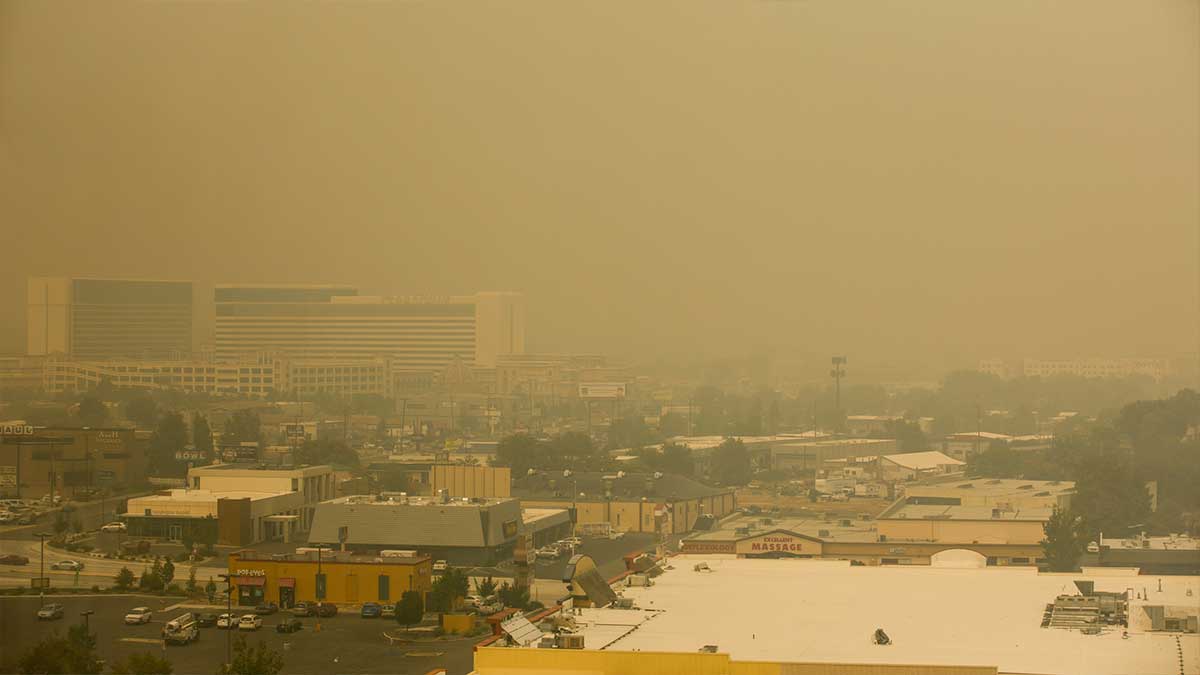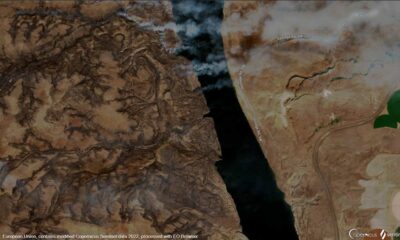Editorial
Editorial: We can no longer ignore the climate crisis that is before us
But the “what now,” feels like an impossible question.

[KIRKLAND] – (MTN) Climate is not weather. Weather is not climate.
A single meteorological event does not prove or disprove climate change. Just as a person cannot look at the devastating snow and ice storms in Texas that killed hundreds and sent gasoline prices soaring this winter, one cannot point to Portland, Oregon reaching 116 degrees this week as proof of climate change. They are single events.
When you look at the events in our home, our planet, this ball of rock, earth, water, and gases spinning around an unassuming C student of a star, a more alarming picture emerges.
Texas has experienced “hundred year floods” almost annually for close to a decade. In 2017 Houston experience several once in a hundred year floods in the same year. But the weather is not climate, and climate is not weather.
1953 was the last year a tornado killed more than 100 people in the United States – that is until 2011. Construction standards were driven by Cold War policy and establishing a national tornado warning system after the Great Worcester Tornado killed 90 people, resulting in more warnings and better construction. Then in 2011, a tornado outbreak over 3 days produced 360 tornadoes and killed 348 people, 158 in Joplin. Tornado season comes earlier, Dixie Alley has expanded further north into Tennessee and Kentucky, and states like Maine are seeing statistically significant increases in tornado-producing storms. But the weather is not climate, and climate is not weather.
Last year there were 30 named tropical storms, the most ever recorded. western Louisiana was hit repeatedly, impacting communities such as Lake Charles with devastating winds and floods. In the 2021 hurricane season, we had 4 named storms before June 30, tying the record for the most named storms this early in the season. The list of fastest growing, strongest winds, lowest barometric pressure, longest-lasting Category V storms continues to grow. But the weather is not climate, and climate is not weather.
Texas has had two once in a hundred year winter storm events and learned nothing and did nothing after the 2011 winter storms brought their electrical grid to its knees. This year hundreds died after power failures disabled medical equipment while others froze to death in their homes. But the weather is not climate, and climate is not weather.
Siberia is once again covered in wildfires, and it is only June. Temperatures have soared to 118 degrees, and in Canada to 121 degrees little more than a week later. The United States is in the worst drought in 1,200 years. Cities and towns in Utah, Arizona, Nevada, Colorado, New Mexico, and California are staring a water crisis in the face. Hoover Dam, a symbol of American will, technology, and engineering prowess, is slowly becoming a monument to hubris. But the weather is not climate, and climate is not weather.
In Alaska, the debate on opening up drilling permits on the North Slope continues to rage, but the point is moot. Almost no oil companies are interested in drilling in Alaska. The melting permafrost has turned the ground into soup during the summer. The ice road season, critical to bringing in heavy materials and equipment, gets shorter every winter.
The weather data before us is undeniable. To call it fake news would require accepting that this is a conspiracy at a planetary level involving governments that actively work against each other such as Russia, China, and the United States. CO2 levels on the planet are at the highest level in 4.5 million years. Melting permafrost in the Arctic releases methane gas trapped in ice, a greenhouse gas ten times more potent than carbon dioxide.
In the Pacific Northwest and Canada, crops literally cooked in the fields. Entire berry harvests have been wiped out from Oregon to British Columbia. Roads buckled from the heat, and the light rail had to stop operating because the tracks were so overheated. Industrial coolers at grocery stores failed and caught fire from the heat, resulting in stores losing their perishable food products. This after 16 months of spot shortages within the supply chain due to COVID.
Young hawk chicks jumped out of nests due to the extreme heat, and rescues are overwhelmed with so many hawks they have to rescue. Lose your raptors, and you get an explosion of rodents. Rodents destroy desired grasses creating erosion, and wipe out crops, as we see in Australia.
On Mount Rainier, 35 inches of snowpack melted in four days. The initial pack was 53 inches, leaving just 18 inches behind. The water is rushing down creeks and rivers and washed away bridges in the park. That water, the Pacific Northwest’s drinking water, is rushing out to the Pacific Ocean. It isn’t supposed to melt that quickly.
Last year in Oregon, Washington, and British Columbia, rain forests burned in defiance of the definition of a rain forest. This year Forks reached 109 degrees on June 28, and although another 100-degree heatwave is improbable for the region, the hottest part of our summer is about six weeks away. Cliff Mass wrote in 2016 that the wildfire smoke that blanketed our region was the product of poor forest management in the United States and unusual wind patterns. Wildfires have gotten worse each since except one, and 2020 was the worst year for smoke in Puget Sound. But the weather is not climate, and climate is not weather.
Greenland is losing 200 billion tons of ice a year, Antarctica, 100 billion. Arctic ice has declined steadily since 1979 in terms of area covered and has lost 66% of its thickness since the first nuclear power submarines sailed below the top of the planet. 85% of the glacier on Mount Kilimanjaro has melted since 1912 and is predicted to disappear in our lifetimes. Glacier National Park is well on its way to having no glaciers within its boundaries. Melting ice exposes darker surfaces, which absorbs more heat and causing higher temperatures.
Al Gore was mocked for an Inconvenient Truth and although there was creative liberty and some things were off the mark (Florida tidal flooding hasn’t reached the scale of the movie, flooding in some communities during normal tides has started), there is a lot he got right.
Communities in Maryland, Louisiana, South Carolina, and Virginia are slowly disappearing due to sea-level rise. The US Navy is working on addressing the sea-level rise in Norfolk. The melting polar ice caps are also considered a military strategic problem that the United States is ignoring. But the weather is not climate, and climate is not weather.
In Canada, it was so hot yesterday some aircraft could not engage in water drops to fight wildfires. For helicopters, the air-cooled engines were overheating even at altitude because the heat was so extreme. The thinner hot air impacts lift for fixed-winged aircraft, reducing the amount of water the aircraft could carry and possible water collection locations.
So what do we do? That’s the real challenge. In the United States, our government has reached a terrifying level of dysfunction with no political will to do anything. Russia is more than content to watch the United States tear itself apart. Indian and China, as rapidly developing nations with over a billion people, are moving to modernize through electrification and building middle-class societies. Both nations are walking away from coal power but are working toward long-term plans, not instant solutions.
China is facing its own energy crisis as 4-million Chinese enter the middle class every month. With a push to walk away from coal energy due to horrible pollution, the nation is pushing to project its power into the oil and natural gas-rich fields of the South China Sea. An effort by China that has been going on since the 1990s.
Here in the United States, there is a need for 7-million more homes because we’re deep in a housing crisis. That many homes require land and infrastructure. That requires cutting down trees, clearing grassland, or converting farmland into housing plots. All of this accelerates warming.
If the answers were simple and short term, we would do them. The human species is awful at setting long-term multigenerational goals. We know from our experiment of shutting down most of the global economy for a year that despite pollution free skies for cities around the world 12 months ago, the needle didn’t move on reducing the CO2 level. For some, that means, “well, what can we do?”
The late comedian George Carlin had this to say. “The planet isn’t going anywhere. We are! We’re going away! We’re going away, and we won’t leave much of a trace either. The planet will be here; we’ll be long gone; just another failed mutation; just another closed-end biological mistake; an evolutionary cul-de-sac. The planet will shake us off like a bad case of fleas, a surface nuisance.”
“The planet will be here for a long time after we’re gone, and it will heal itself, it will cleanse itself cause that’s what it does. It’s a self-correcting system. The air and the water will recover, the earth will be renewed, and if it’s true that plastic is not degradable, well, the planet will simply incorporate plastic into a new paradigm: The Earth plus Plastic.”
Humans cannot inhabit places that reach 122 degrees (50 degrees Centigrade) without massive infrastructure. Even then, being outside for more than a few hours can be fatal, even for the healthy. In the United States, the list of cities and towns creeping closer to those record highs, or exceeding them, are growing. Trained soldiers in the desert are in far better shape than the half of the United States that is obese and the one-third of the countries with diabetes or pre-diabetes.
The grim reality is this isn’t about saving the planet or the countless species that live with us who are dying off at the fastest rate in planetary history as I type this. Carlin is 100% correct, and the earth can shake us off like a bad case of fleas anytime it wants to, and nothing will care. The planet has shown that some other creature who found a way to survive, adapt, in this mess partially of our creation will live off of our wreckage, slowly evolve, and take over the surfaces or the seas, and everything we were will be forgotten forever. Even the satellites orbiting earth will eventually deorbit over time and disappear. The only traces left being microplastics, deeply buried ruins, and some strange pieces of equipment resting on planets in our solar system that must have been put there by some intelligent alien race.
Now that isn’t to say the end is near, and this great removal of the human flea on planet Earth is happening next year or the next decade. But if we don’t do something about it, we will soon live on a planet fighting increasing harsher wars over arable land, potable water, and places with temperatures below 122 degrees. We need to choose wisely in the few years we have left to respond.
If you’re looking to me to provide an answer on what to do, I don’t have one. I simply don’t know. If I use an analogy of a car, we have been driving a car, and now and then, the engine temperature gauge gets just below the red, and the check engine light is on. But instead of doing something about it, we keep driving. The car is still running today, but the engine temperature is now in the red, and steam is coming from the engine bay. The passenger in our backseat is screaming, “No! No! Don’t stop! Just keep driving because if you stop driving, everything will break.”
Save the planet? Who is going to save us, if not us.










